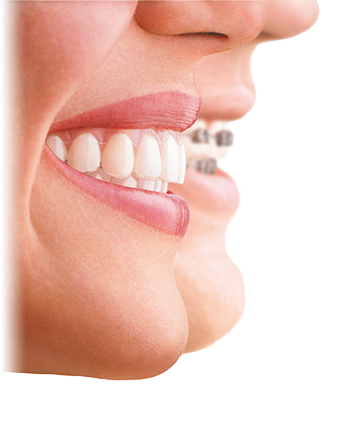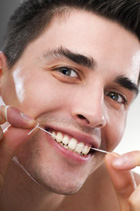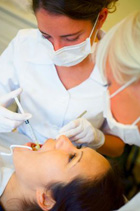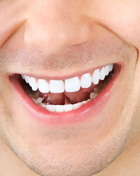 Chewing gums benefits can be substantial to our oral health. Whether it is to freshen breath or contribute to increased production of saliva, many of us chew gum. Saliva is a vital force in protecting our teeth from the damaging effects of plaque and chewing gum is one of the simplest ways to achieve that.
Chewing gums benefits can be substantial to our oral health. Whether it is to freshen breath or contribute to increased production of saliva, many of us chew gum. Saliva is a vital force in protecting our teeth from the damaging effects of plaque and chewing gum is one of the simplest ways to achieve that.
Having a dry mouth can be very uncomfortable indeed and the pleasurable process of chewing gum helps to alleviate that. As a happy side effect your breath is freshened in the process. Feeling confident that your breath smells pleasant is very important for social occasions of all kinds, allowing you to talk and smile with confident without being worried that you ought to shield your mouth.
The saliva that is produced by the act of chewing neutralises acids which are introduced to the mouth via sugary and starchy foods. By combating these acids you are helping to guard against plaque, safeguard your teeth’s protective enamel and avoid painful cavities and tooth decay.
Chewing also helps clear the mouth of debris. If you find yourself in a situation where brushing is not possible – perhaps a business function involving lunch – chewing gum is the next best thing until you are able to use your toothbrush. The process of chewing will help to shift some of your food debris away from teeth and neutralise acids in the process.
The likelihood of stains is also reduced allowing your teeth to retain some of their whiteness. There are many different chewing gums available on the market and your Leeds dentist will be able to advise you on the best so that you maintain healthy saliva production and fresh breath.





 Imagine being able to have your false tooth fitted in a single visit to your dentist. In the past this process could take a fortnight or more, but CEREC technology has changed all that, allowing dentists to design, construct and fit new crowns, veneers, onlays and underlays in just one session. Achieve lasting results with this efficient procedure available in the City of Leeds.
Imagine being able to have your false tooth fitted in a single visit to your dentist. In the past this process could take a fortnight or more, but CEREC technology has changed all that, allowing dentists to design, construct and fit new crowns, veneers, onlays and underlays in just one session. Achieve lasting results with this efficient procedure available in the City of Leeds. Maintaining your home oral hygiene routine is vital in maintaining healthy teeth and gums. Six month check ups with your dentist are very important, as is pursuing a balanced diet, but in the mean time it is crucial that you take good care of your teeth at home by brushing and flossing.
Maintaining your home oral hygiene routine is vital in maintaining healthy teeth and gums. Six month check ups with your dentist are very important, as is pursuing a balanced diet, but in the mean time it is crucial that you take good care of your teeth at home by brushing and flossing. Crooked, misaligned teeth have many causes, from trauma to childhood thumb-sucking. They can dash one’s confidence and lead to a lifetime of poor oral hygiene. Central Leeds dentists are now offering a chance to put an end to this forever with the fitting of braces. Why delay achieving your perfect smile? Braces work with your teeth to ensure lasting, optimum alignment and bite that will mean you can show off your teeth with confidence.
Crooked, misaligned teeth have many causes, from trauma to childhood thumb-sucking. They can dash one’s confidence and lead to a lifetime of poor oral hygiene. Central Leeds dentists are now offering a chance to put an end to this forever with the fitting of braces. Why delay achieving your perfect smile? Braces work with your teeth to ensure lasting, optimum alignment and bite that will mean you can show off your teeth with confidence. Maintaining healthy gums is just as vital for oral hygiene as looking after your teeth. With experts suggesting that as many as seventy five per cent of Britons over thirty five years of age have some form of gum disease it has never been more important to take your gum’s health seriously. Bleeding gums are a sign that gum disease is taking hold and you should contact your Central Leeds dentist immediately if you notice it occurring.
Maintaining healthy gums is just as vital for oral hygiene as looking after your teeth. With experts suggesting that as many as seventy five per cent of Britons over thirty five years of age have some form of gum disease it has never been more important to take your gum’s health seriously. Bleeding gums are a sign that gum disease is taking hold and you should contact your Central Leeds dentist immediately if you notice it occurring. Under normal circumstances the roots and ligaments which hold your primary or baby teeth in place will dissolve and allow your adult teeth to come through and replace them. Sometimes they don’t dissolve properly and end up fused with your jaw bone. This condition is called ankylosis and should be treated as soon as it is diagnosed.
Under normal circumstances the roots and ligaments which hold your primary or baby teeth in place will dissolve and allow your adult teeth to come through and replace them. Sometimes they don’t dissolve properly and end up fused with your jaw bone. This condition is called ankylosis and should be treated as soon as it is diagnosed. It is the job of an oral pathologist to diagnose disease in the mouth and recommend immediate treatment, writes a dentist in Leeds. The mouth is an important gateway to the body. Hence, maintaining its health and being able to recognise the causes of oral diseases are paramount. Bad oral hygiene, diet, poor immune systems, stress, smoking and heavy drinking can put extreme stresses on the mouth. It can start with plaque and tartar, leading to tooth decay, gum infections, periodontal and salivary disease- abscesses and lesions can develop, as well as oral cancer. If there are any signs of problems, it is the pathologist’s role is carry out extensive examinations using x-rays, radiographs, dental imaging, biopsies and biochemical examinations of the oral and maxillofacial regions in order to come to a precise diagnosis of the disease and then design a course of treatment. This often involves surgery and the pathologist will work closely with other specialists such as orthodontists, endodontists and periodontists to ensure that the best procedures lead to the best results for the patient.
It is the job of an oral pathologist to diagnose disease in the mouth and recommend immediate treatment, writes a dentist in Leeds. The mouth is an important gateway to the body. Hence, maintaining its health and being able to recognise the causes of oral diseases are paramount. Bad oral hygiene, diet, poor immune systems, stress, smoking and heavy drinking can put extreme stresses on the mouth. It can start with plaque and tartar, leading to tooth decay, gum infections, periodontal and salivary disease- abscesses and lesions can develop, as well as oral cancer. If there are any signs of problems, it is the pathologist’s role is carry out extensive examinations using x-rays, radiographs, dental imaging, biopsies and biochemical examinations of the oral and maxillofacial regions in order to come to a precise diagnosis of the disease and then design a course of treatment. This often involves surgery and the pathologist will work closely with other specialists such as orthodontists, endodontists and periodontists to ensure that the best procedures lead to the best results for the patient. If you are resigned to the fact that you have to wear a brace, chances are you’re thinking of the more traditional methods where you are subjected to up to 3 years of hell. Well you should think again, says a dentist from the city of Leeds. The field of orthodontics deals with maintaining the correct alignment to occlusion or the bite of the jaw. To do this can involve the fitting of braces. But with the advances in technology and modern dentist procedures, this doesn’t have to be a long drawn out process anymore, thanks to three revolutionary techniques. The Inman aligner is aimed primarily at the front teeth of adults. A coil spring exerts pressure on the teeth, whilst a bar behind reverses that pressure. The result is that the teeth are gently pushed and pulled into position and the process can be over in as little as 6 weeks. This is also a lot cheaper than other techniques. The Damon brace uses a self-ligating wire to allow the brace to move with the teeth. It appears discreet in the mouth and is easy to clean and quicker than conventional braces. The most expensive option is the Invasalign. An ‘invisible’ retainer is fitted to the teeth and can carry out full adjustment of the teeth in a minimum of 12 months. It has to be changed every month, but its main advantage is that it can be removed during eating and when cleaning the teeth.
If you are resigned to the fact that you have to wear a brace, chances are you’re thinking of the more traditional methods where you are subjected to up to 3 years of hell. Well you should think again, says a dentist from the city of Leeds. The field of orthodontics deals with maintaining the correct alignment to occlusion or the bite of the jaw. To do this can involve the fitting of braces. But with the advances in technology and modern dentist procedures, this doesn’t have to be a long drawn out process anymore, thanks to three revolutionary techniques. The Inman aligner is aimed primarily at the front teeth of adults. A coil spring exerts pressure on the teeth, whilst a bar behind reverses that pressure. The result is that the teeth are gently pushed and pulled into position and the process can be over in as little as 6 weeks. This is also a lot cheaper than other techniques. The Damon brace uses a self-ligating wire to allow the brace to move with the teeth. It appears discreet in the mouth and is easy to clean and quicker than conventional braces. The most expensive option is the Invasalign. An ‘invisible’ retainer is fitted to the teeth and can carry out full adjustment of the teeth in a minimum of 12 months. It has to be changed every month, but its main advantage is that it can be removed during eating and when cleaning the teeth. Implants have come a very long way since they first hit the scene way back in Sweden. Computers have revolutionised implant designs and methods and will continue to do so in the future, according to a dentist in central Leeds. The principles of implants still remain. A hole is drill into the jaw and the new ‘root’ screwed in. Once the healing process is complete, the new bridge or crown can be attached. But the methods by which all these processes are carried out have progressed tremendously. There are three radical advances in screw to bone techniques. The bio-horizons’ implant technology, the ankylos implant system and the syncone system. All of these methods are tailored to what’s best for each individual patient. Some people may need a ‘little less of that and bit more of this’ to define the precise treatment required and each of these techniques, with the use of computer programs and analysis scanners, use state of the art surgery techniques to achieve their goals- piezo surgery is one of these techniques. It centres on cutting the bone and leaving the gum intact, reducing damage to nerve tissue, healing time and the risk of infection. Healing processes have advanced too. Plasma rich growth factor uses a combination of proteins that stimulate and house new bone synthesis and regenerate soft tissue. With such attention to detail and advancement in technology, having implants fitted can be better than the real thing!
Implants have come a very long way since they first hit the scene way back in Sweden. Computers have revolutionised implant designs and methods and will continue to do so in the future, according to a dentist in central Leeds. The principles of implants still remain. A hole is drill into the jaw and the new ‘root’ screwed in. Once the healing process is complete, the new bridge or crown can be attached. But the methods by which all these processes are carried out have progressed tremendously. There are three radical advances in screw to bone techniques. The bio-horizons’ implant technology, the ankylos implant system and the syncone system. All of these methods are tailored to what’s best for each individual patient. Some people may need a ‘little less of that and bit more of this’ to define the precise treatment required and each of these techniques, with the use of computer programs and analysis scanners, use state of the art surgery techniques to achieve their goals- piezo surgery is one of these techniques. It centres on cutting the bone and leaving the gum intact, reducing damage to nerve tissue, healing time and the risk of infection. Healing processes have advanced too. Plasma rich growth factor uses a combination of proteins that stimulate and house new bone synthesis and regenerate soft tissue. With such attention to detail and advancement in technology, having implants fitted can be better than the real thing! When is a hopeless tooth considered to be a hopeless? You would have thought the answer would be obvious. It’s in the title- hopeless. But as any dentist in Leeds will tell you, it isn’t that easy a decision to make. 50 years ago, the decision to remove a tooth was a lot easier. Now however, with modern techniques and treatments, a dentist would rather pull out all the stops, than pull out the tooth. Generally, there are two major factors to consider before rendering a tooth a lost cause- restorability and periodontal support. Modern advances in treatments make most teeth restorable. Most endodontic techniques can restore a damaged or decayed tooth. By using root canal treatment, the affected tooth can be can be saved by the removal of the roots, dead tissue and nerves and then having the hole cleaned and filled, before deciding whether to cap the tooth. This will restore function. But what runs deeper at this point is just how much damage has been caused to the surrounding area by the damage or the decay to the tooth. Periodontic diagnosis of the area around the tooth relies on how advanced the disease has become. It will rely on the pocket depth between the tooth and gum, the decay in the bone supporting the tooth, the level of mobility in the tooth and the crown to root ratio. And before rendering the tooth hopeless, there are two final factors to consider before the tooth is condemned. The rate of progression of periodontal disease and the age of the patient- the older the patient, the more likely the tooth will be removed.
When is a hopeless tooth considered to be a hopeless? You would have thought the answer would be obvious. It’s in the title- hopeless. But as any dentist in Leeds will tell you, it isn’t that easy a decision to make. 50 years ago, the decision to remove a tooth was a lot easier. Now however, with modern techniques and treatments, a dentist would rather pull out all the stops, than pull out the tooth. Generally, there are two major factors to consider before rendering a tooth a lost cause- restorability and periodontal support. Modern advances in treatments make most teeth restorable. Most endodontic techniques can restore a damaged or decayed tooth. By using root canal treatment, the affected tooth can be can be saved by the removal of the roots, dead tissue and nerves and then having the hole cleaned and filled, before deciding whether to cap the tooth. This will restore function. But what runs deeper at this point is just how much damage has been caused to the surrounding area by the damage or the decay to the tooth. Periodontic diagnosis of the area around the tooth relies on how advanced the disease has become. It will rely on the pocket depth between the tooth and gum, the decay in the bone supporting the tooth, the level of mobility in the tooth and the crown to root ratio. And before rendering the tooth hopeless, there are two final factors to consider before the tooth is condemned. The rate of progression of periodontal disease and the age of the patient- the older the patient, the more likely the tooth will be removed.

